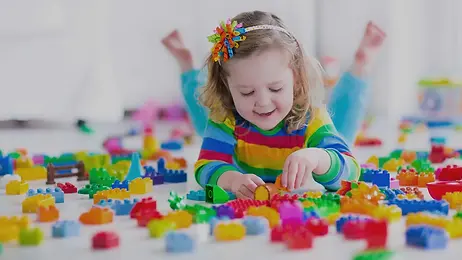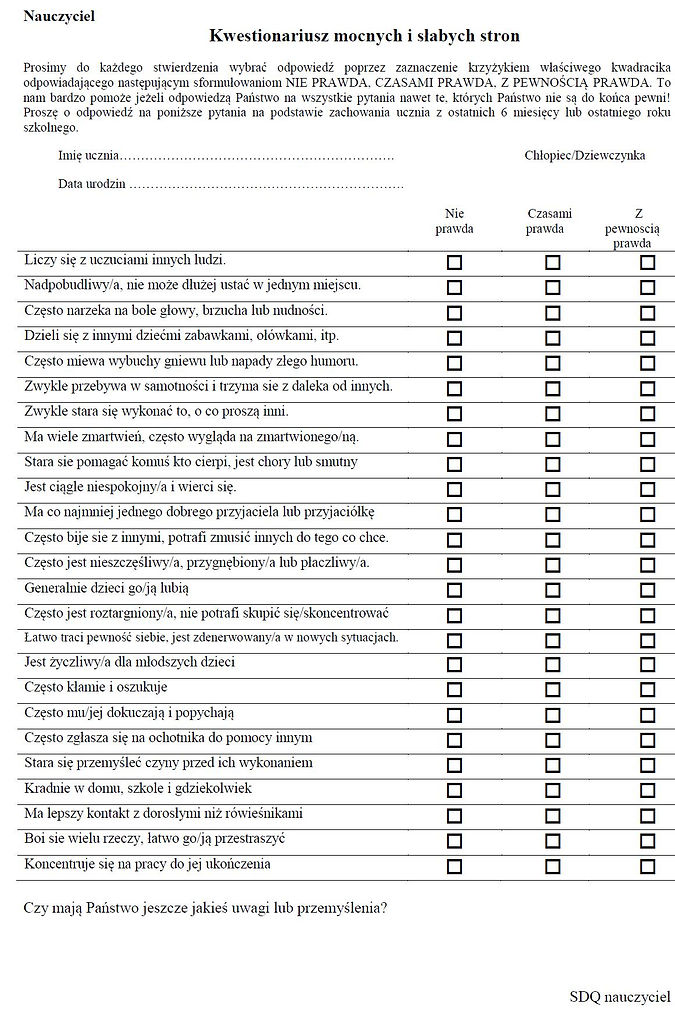
Therapy through play
Through play, therapists can help children learn more adaptive behaviors in situations in which the child presents emotional or social deficits.
About the method
What is Play Therapy?
Play Therapy is a structured, theoretical approach to therapy based on the child's learning and communication processes (Carmichael, 2006; Landreth, 2002; O. Connor & Schaefer, 1983). This method uses children's basic activity, which is playing. The therapist plays an active role in it, because by being emotionally attuned to children, they give them the opportunity to express themselves through play. During therapy, thanks to the unconditional acceptance of therapists, children have the opportunity to exist and be themselves. Therapists use Play Therapy long-term, strategically to help children express what is problematic for them when children do not have the verbal skills to express their thoughts and feelings (Gil, 1991).
Through play, therapists can help children learn more adaptive behaviors in situations in which they present emotional or social deficits (Pedro-Carroll & Reddy, 2005). The positive relationship that develops between the therapist and the child during a Play Therapy session provides corrective emotional experiences that are essential to treatment (Moustakas, 1997). Play Therapy can also be used to stimulate cognitive development and provides insight into a child's dysfunctional thinking and internal conflicts, providing the child with ways to resolve them (O?Connor & Schaefer, 1983; Reddy, Files-Hall & Schaefer, 2005)


History of Play Therapy
Play Therapy was proposed by American therapist Virginia Mae Axline. Her concept is an adaptation of the principles of non-directive client-centered therapy by Carl R. Rogers, who emphasized the value of striving for self-fulfillment, which is the main life force. V.Axline proposed that the principle of non-directivism should also be applied in the process of child psychotherapy, basing it on play. In 1947, "Play Therapy" was first published and used in various forms by therapists of all theoretical orientations. When creating Play Therapy, V.Axline assumed that a child has the ability to solve his mental problems. The basis for establishing contact between the therapist and the child is to adapt the therapist's activity to the child's current activity. The therapist emphasizes and realizes the child's subjectivity by following the child's lead. The assumptions of V.Axline have been included in eight principles of therapeutic contact with children.

Main principles of Play Therapy
by V. Axline
-
Creating a warm and friendly relationship with the child based on trust.
-
Accepting the child as he is.
-
Creating a sense of security so that the child can express himself freely.
-
The child has the right to choose and is responsible for his or her choices.
-
The therapist shares and reflects the emotions expressed by the child.
-
The child leads, the therapist follows.
-
The therapist does not speed up the therapeutic process.
-
The therapist creates boundaries that will anchor the child in reality and support his or her sense of responsibility.
Play Tool Kit - therapeutic tools
A Play Therapy therapist integrates various types of play and creative techniques in his work. This distinguishes him from other therapists (e.g. drama therapist, art therapist, choreographer). During a therapeutic session, called "Special Time", the therapist uses a set of therapeutic tools, the so-called Play Tool Kit. These include:
-
sandbox with blue bottom and side walls,
-
a set of figures for playing in the sandbox, representing human figures, domestic and wild animals, buildings, plants, positive and negative characters from fairy tales, insects, crystals, stones, etc.
-
puppets of human figures, animals, 2 of each type,
-
various musical instruments, 2 of each type,
-
costumes and masks,
-
materials for physical expression, e.g. balls, sashes, ropes, tapes, blanket,
-
materials for creative activities, e.g. paints, crayons, markers, clay, play dough, papers
-
and therapeutic stories and creative visualizations - created individually for each child.
The choice of activity is always up to the child. The therapist's task during the first session is to present the Play Tool Kit equipment to the child so that he or she can freely choose his or her preferred activities.

Duration of therapy
One session lasts 40-45 minutes. The number of sessions depends on the severity of the child's difficulties. In case of slight difficulties, 6 meetings are recommended. For greater difficulties - 15 sessions. In case of serious difficulties, the therapy lasts 6-12 months.
Effectiveness of Play Therapy
Between 74-83%* of children using Play Therapy conducted in accordance with PTI (Play Therapy International) standards showed positive changes.
The scale of improvement depends on the severity of the disorder: greater improvement is seen in more severe disorders
Greater improvement was confirmed in younger children (6 years old - 80%; 12 years old - 71%).
Greater improvement occurred in girls (79%) than in boys (73%).
* results of a 10-year research program assessing the effectiveness of Play Therapy and creative therapy through art - conducted by PTUK (Play Therapy United Kingdom)
The effectiveness of therapy in PTI is measured by, among others: Strengths and Difficulties Questionnaire SDQ - R. Goddman.
The questionnaire measures the child's difficulties on four scales:
-
emotional symptoms (emotional problems),
-
conduct problems,
-
hyperactivity and concentration disorders (hyperactivity),
-
problems in contacts with peers (peer problems).
The questionnaire also includes a scale measuring the child's strengths: the child's prosocial skills.
The SDQ is completed by the parents, the child and the person referring the therapy (usually a teacher) before starting and ending therapy.


The role of a parent in Play Therapy
-
observing the child in everyday life,
-
active involvement,
-
ensuring consistency of therapy.
The parent is an active participant in the therapeutic process, although he or she does not participate in the child's individual therapeutic session.
The parent's task during therapy is to observe the child in everyday life and changes in his or her behavior both within the family and in the broader social environment. After every sixth session with the child, the therapist meets with the parents for the so-called review session to discuss the observed changes, jointly reflect on the causes of the child's difficulties and ways of dealing with them. During a review session with a Play Therapy therapist, the parent gains the opportunity to develop the reflective function, which, according to A. Slade, is the basis necessary for the development of a sense of understanding oneself and others. The parent's self-understanding brings benefits to the child in the form of accepting the child and understanding his or her behavior instead of judging. A high level of family involvement in the above-mentioned therapy is crucial to achieving the expected changes in the child's functioning.
The role of the therapist in Play Therapy
-
active involvement,
-
reflecting the child's emotions,
-
allowing the child to express himself,
-
creating rules and boundaries,
-
accepting the child,
-
not praising the child,
-
not judging the child
In non-directive play therapy, the role of the therapist is very active. The therapist is an element of the therapeutic relationship. The therapist's attitude during a Play Therapy session is full of vigilance and sensitivity to what the child communicates, does, and says. The basic goal of the therapist's work is to reflect the child's feelings and behaviors, thanks to which he or she has the opportunity to create a sense of self.
The therapist, acting synchronously through facial expressions, varying the pace and intensity of movement, gestures, vocalizations, as well as through verbal messages, reflects the emotions experienced by the child. The therapist creates a mirror in which the child gets to know himself and experiences himself as existing in the mind of another person. Thanks to this experience, the child can build an image of himself based on his own experience, and not on opinions coming from the environment.
-
The therapist allows the child to fully express himself in a non-verbal, verbal and physical way. The child is not reprimanded in any way by the therapist or made to feel guilty for his or her feelings and actions. There is also no praise from the therapist, because the most important thing during the session is the child's own assessment. The therapist does not require any changes from the child. During the session, the child's actions are not assessed by the therapist as good or bad. This attitude of the therapist is related to complete acceptance of the child as he or she is. Thanks to this, the relationship becomes symmetrical, there is no advantage of the adult being better or wiser than the child.
-
During a Play Therapy session, the therapist creates boundaries that ensure the safety of both the child and the therapist. You don't set boundaries for a child, they are created when circumstances arise. Thanks to boundaries, children learn responsibility for their own actions.
Requirements for a Play Therapy therapist
Conducting Play Therapy requires extensive, specialized education, training and clinical experience. Therapists who meet all of the following criteria are authorized to conduct PLAY THERAPY therapy:
-
They have higher education in the humanities or medical sciences.
-
They successfully completed the training, the program and course of which were approved by the International Board of Examiners of Child and Play Therapy.
-
They are subject to the ethical principles of Play Therapy International (PTI).
-
They have a current clean criminal record certificate (renewed once a year along with PTI membership).
-
They are members of Play Therapy International or its affiliates.
-
They are subject to close supervision (1 hour of supervision per 6 hours of therapy).
-
They regularly report the effects of their work and improve their qualifications in accordance with PTI principles.





